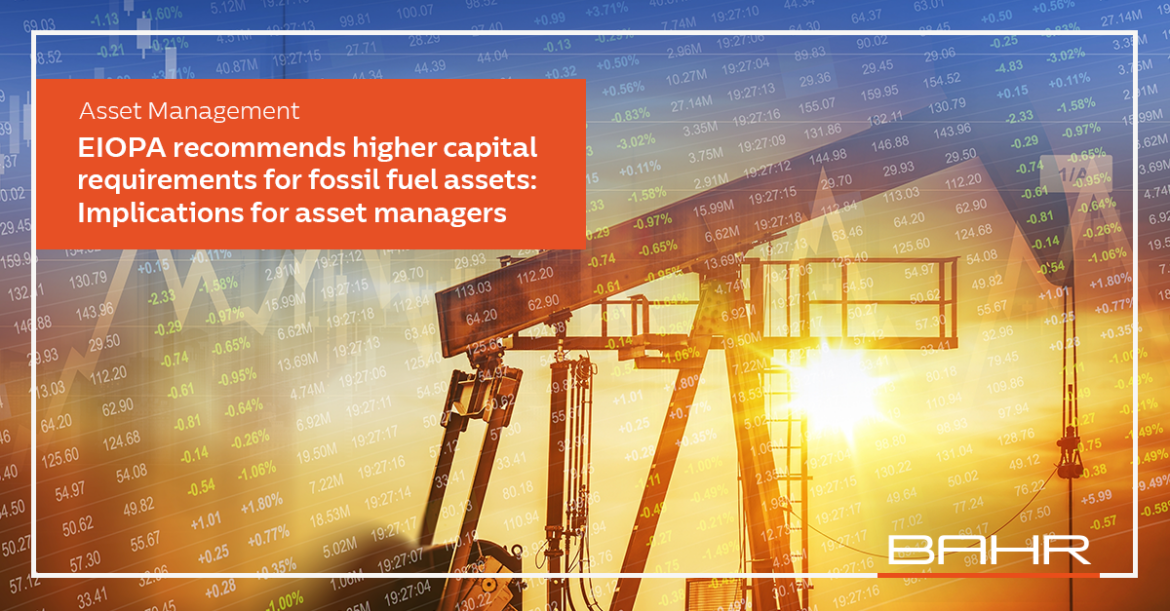Asset Management | EIOPA recommends higher capital requirements for fossil fuel assets: Implications for asset managers

Background
Solvency II (Directive 2009/138/EC) provides the regulatory framework for insurance and reinsurance undertakings within the European Union. Insurance companies, as institutional investors, manage extensive portfolios across various asset classes, including long-term illiquid investments such as private equity and infrastructure funds. Insurance undertakings must hold funds to cover the solvency capital requirement, ensuring they can withstand unexpected losses in a one-in-two-hundred-year event within a one-year horizon. The solvency capital requirement is calculated based on, inter alia, the types of assets an insurance undertaking invests in.
The attractiveness of an investment fund to an insurance company is impacted by the capital requirements imposed on its investments. Consequently, these regulations are directly relevant for asset managers. Some managers are already adept at aligning mandates with capital requirement rules, such as those involving qualifying infrastructure, which benefits from a more lenient capital requirement regime.
EIOPA’s Recommendations
EIOPA published a Report on 7 November 2024 on the effects of dedicated prudential treatment for assets or activities associated substantially with environmental and/or social objectives, or which substantially harm such objectives, including fossil fuel related assets. The report emphasizes the importance of transition risk for long-term investors like insurance companies (p. 10):
… firms need to adapt their business models quickly to a low carbon economy. Firms unable to transition in the short to medium term or even unable to transition at all and thereby continuing to contribute to climate change materially may be impacted by transition risks, induced by changes in regulation or market sentiment, negatively affecting their business performance. For instance, if transition risks materialize in more volatile cash-flows for firms engaging in environmentally harmful economic activities due to changes in market sentiment in terms of investor or consumer preferences, the financial instruments issued by these firms should show elevated levels of market risks relative to firms with less harmful activities.
EIOPA concludes that fossil fuel-related stocks and bonds have “a clear and heightened risk” relative to other economic activities (p. 62). EIOPA recommends increasing capital requirements for insurance companies investing in these assets, specifically by 17% for equity investments, and 40% for bonds. The capital requirements under Solvency II shall as a starting point be calculated by using a ‘look-through approach’, i.e. based on the underlying portfolio investments of funds.
EIOPA also addresses other areas beyond fossil fuels:
- The risk of stranded properties, driven by factors such as increased regulation, policy pressure to reduce GHG emissions and costs of indirect emissions. Since the evidence linking energy efficiency and property risk from a prudential perspective was found to be mixed, EIOPA recommends further assessment as data availability improves.
- Social risks are acknowledged as having an impact on insurance companies’ business activities. EIOPA recommends further assessment on this topic due to lack of a methodology to assess, for example, how labor and human rights violations can lead to direct financial losses.
Practical implications for the asset management industry
Insurance and reinsurance companies are the largest institutional investors in Europe. Regulatory changes affecting their investment strategies can generally impact the whole asset management industry and shift capital flows. If fossil fuel assets on an insurance company’s balance sheet requires more capital to be set aside compared to other assets, insurers may steer clear of new investments in fossil fuel assets. In addition, insurance companies may seek to offload existing exposures, by divesting from fossil fuel exposures or by ensuring that such exposures are moved off the consolidated balance sheet.
For asset managers, aligning investment products and mandates with evolving capital requirement rules is essential to attract institutional investors and insurance company funds. The practical implications of higher capital requirements for fossil fuels assets are expected to be limited, as new funds with fossil fuel strategies are unlikely. However, it could impact the secondary market and increase LP-led secondary deals in funds with fossil fuel exposures.
The European Commission will now assess EIOPA’s policy recommendations, which has been subject to concern also from a minority of the report’s authors. Concerns include the imposition of stricter capital requirements solely on insurers, without equivalent obligations for banks, high implementation costs, limited impact due to insurers’ low fossil fuel exposure, and potential obstacles to transition financing. In light of these concerns, it is relevant to note that EIOPA, alongside ESMA, EBA, and the European Central Bank, recently released the results of a “Fit-For-55” climate stress scenario. The findings suggest that transition risks alone are unlikely to threaten financial stability. Further, the need for a coordinated policy approach to finance the transition is highlighted.
Given the concerns raised and the findings from the “Fit-For-55” climate stress scenario, it remains to be seen whether these recommendations will eventually lead to legislative changes.
BAHR Comments
If adopted, EIOPA’s recommendations represents a step towards differentiating between “brown” (high-risk, non-sustainable) and “green” (low-risk) exposures in capital requirement rules. Although these rules are not explicitly designed to fulfill EU policy objectives, such as those in the European Green Deal, they are developed to ensure market stability while also taking into account environmental and social factors to the extent they affect solvency, customer protection, and financial stability.
The capital requirement rules should be considered by asset managers alongside other EU initiatives within sustainable finance. This is an area where the EU is moving rapidly, and we encourage asset managers to stay ahead of these regulatory changes and assess how capital requirement rules may impact the investment strategies of new products.
